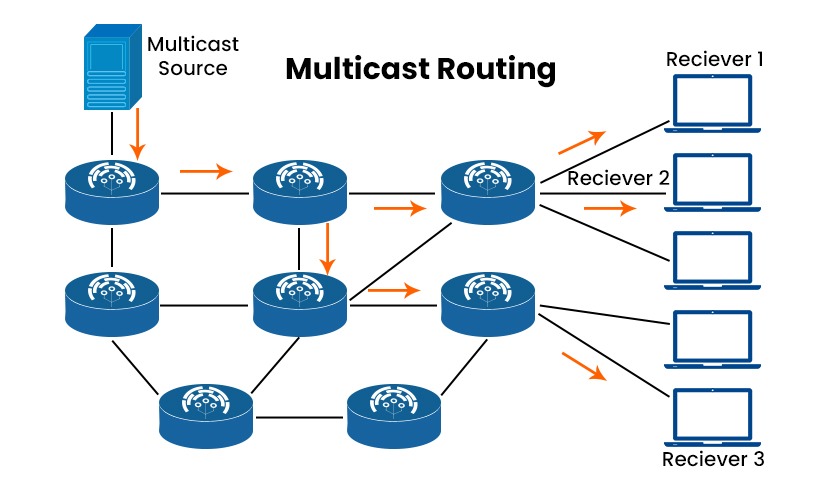pim,pim demo,pim costs,pim tests
SPOTO offers 100% real & valid Cisco, PMP, ISACA, AWS, and other IT exam dumps to help you pass IT
exams. We will list out pim tips, pim demo, pim tutorial, pim cost, pim latest industry news, all things you
concern about the Certification online proctored exam.
-
- 1388
- SPOTO
- 2024-06-20 15:54
pim,pim demo,pim costs,pim tests
SPOTO offers 100% real & valid Cisco, PMP, ISACA, AWS, and other IT exam dumps to help you pass IT
exams. We will list out pim tips, pim demo, pim tutorial, pim cost, pim latest industry news, all things you
concern about the Certification online proctored exam.
-
- 1388
- SPOTO
- 2024-06-20 15:54
Introduction to Multicast Routing Multicast routing is an essential concept in modern network communication, particularly for efficiently distributing data to multiple recipients. Unlike unicast (one-to-one) or broadcast (one-to-all), multicast routing allows the delivery of information to a group of destinations simultaneously, reducing bandwidth consumption and improving network performance. In this blog, we'll explore key technical terms and concepts related to multicast routing as covered in Chapter 11 of the Cisco CCIE Routing and Switching v5.0 Official Cert Guide. Multicast Basics What is Multicast? Multicast is a method of communication where data is transmitted from one sender to multiple receivers. Unlike broadcast, which sends data to all devices on a network, multicast targets a specific group of receivers. This approach is highly efficient for applications like video conferencing, online streaming, and real-time data feeds. Multicast Addressing Multicast uses a specific range of IP addresses (224.0.0.0 to 239.255.255.255 for IPv4) to identify multicast groups. Devices interested in receiving multicast traffic must join the corresponding multicast group. The communication happens at both the network and data link layers, utilizing IP multicast addresses and MAC addresses designed for multicast. Internet Group Management Protocol (IGMP) What is IGMP? Internet Group Management Protocol (IGMP) is used by IPv4 systems to report their multicast group memberships to adjacent routers. IGMP plays a crucial role in managing multicast group membership on a local network, ensuring that routers know which devices want to receive specific multicast streams. IGMP Versions IGMPv1: The simplest form, allowing hosts to join multicast groups but not leave them explicitly. IGMPv2: Introduced the leave group message, enabling more efficient management of group membership. IGMPv3: Added support for source-specific multicast (SSM), allowing hosts to specify which sources they want to receive traffic from. Protocol Independent Multicast (PIM) Overview of PIM Protocol Independent Multicast (PIM) is a family of multicast routing protocols that provide efficient routing of multicast packets. PIM is called "protocol independent" because it can operate over various underlying unicast routing protocols. PIM Dense Mode (PIM-DM) PIM-DM is suitable for environments where multicast group members are densely distributed. It uses a flood-and-prune mechanism to build the multicast distribution tree. Initially, multicast traffic is flooded to all parts of the network, and then branches without receivers are pruned back. Flooding: Multicast traffic is sent to all routers. Pruning: Routers without group members send prune messages to stop receiving unwanted traffic. PIM Sparse Mode (PIM-SM) PIM-SM is designed for environments where multicast group members are sparsely distributed. It uses a rendezvous point (RP) to manage group membership and build multicast distribution trees more efficiently. Rendezvous Point (RP): A router that acts as the meeting point for multicast sources and receivers. Join/Prune Mechanism: Routers send join messages towards the RP to indicate interest in a multicast group. Prune messages are sent to stop receiving traffic when there are no interested members. Multicast Border Gateway Protocol (MBGP) What is MBGP? Multicast Border Gateway Protocol (MBGP) extends BGP to support multicast routing. It allows the exchange of multicast routing information between different autonomous systems, ensuring efficient delivery of multicast traffic across the internet. MBGP Functionality MBGP maintains separate routing tables for unicast and multicast routes, ensuring that multicast traffic follows optimal paths. This separation allows for more flexible and efficient routing of multicast traffic, especially in complex network environments. Multicast Source Discovery Protocol (MSDP) Overview of MSDP Multicast Source Discovery Protocol (MSDP) is used in conjunction with PIM-SM to enable multiple RPs to share information about active multicast sources. This helps in creating a seamless and efficient multicast routing infrastructure across multiple domains. MSDP Mechanics Source Advertisement (SA) Messages: Used by RPs to announce the presence of active multicast sources to other RPs. SA Caching: Routers cache received SA messages to quickly forward join messages to the appropriate sources. Bidirectional PIM (BIDIR-PIM) What is BIDIR-PIM? Bidirectional PIM (BIDIR-PIM) is a variant of PIM-SM that simplifies the multicast routing process by allowing traffic to flow bidirectionally on a single multicast distribution tree. This approach reduces the complexity and overhead associated with managing multiple unidirectional trees. Advantages of BIDIR-PIM Simplified Tree Management: Single bidirectional tree reduces the need for maintaining separate source-specific trees. Scalability: Better suited for large-scale multicast deployments with numerous group members and sources. Multicast routing is a powerful and efficient method for distributing data to multiple recipients in a network. Understanding the various protocols and mechanisms, such as IGMP, PIM, MBGP, MSDP, and BIDIR-PIM, is essential for designing and managing modern multicast-enabled networks. By leveraging these technologies, network engineers can optimize bandwidth usage and enhance the overall performance of multicast applications. Incorporating multicast routing into your network can significantly improve the delivery of data-intensive applications, ensuring a seamless and efficient user experience. As multicast technology continues to evolve, staying updated with the latest protocols and best practices will be crucial for any communications engineer working in today's dynamic networking landscape.
